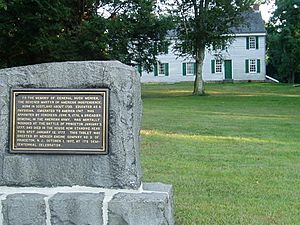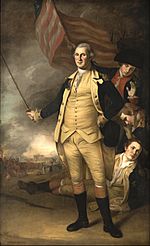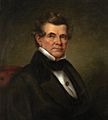Hugh Mercer facts for kids
Quick facts for kids
Hugh Mercer
|
|
|---|---|
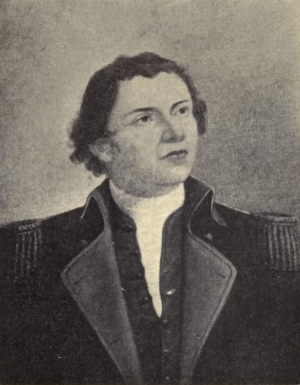
Hugh Mercer
|
|
| Born | 16 January 1726 Pitsligo, Aberdeenshire, Scotland |
| Died | 12 January 1777 (aged 50) Princeton, New Jersey |
| Place of burial |
Laurel Hill Cemetery, Philadelphia
|
| Allegiance | |
| Service/ |
|
| Years of service | Jacobite Army (1745–1746) Pennsylvania Militia (1755–1776) Continental Army (1776–1777) |
| Rank | Brigadier general (Continental Army) |
| Battles/wars | Jacobite rising of 1745 |
| Alma mater | University of Aberdeen |
| Relations | Hugh W. Mercer (grandson) Johnny Mercer and George S. Patton (great-great-great grandsons) |
| Other work | Surgeon, apothecary |
Hugh Mercer (born January 16, 1726 – died January 12, 1777) was a brave military leader and doctor. He was born in Pitsligo, Scotland. He played important roles in two major wars. These were the Seven Years' War and the American Revolutionary War.
Mercer first studied medicine in Scotland. He even fought with the Jacobite forces. These forces supported Bonnie Prince Charlie. He was at the Battle of Culloden in 1746. After the Jacobite uprising failed, Mercer had to escape. He moved to Pennsylvania in America.
In America, he joined the British colonial forces. He fought alongside a young George Washington in the French and Indian War. Mercer was seriously hurt in 1756. Later, he settled in Virginia. He continued his work as a doctor. He became a brigadier general in the American Continental Army. He was also a close friend of George Washington. Mercer died from injuries he received at the Battle of Princeton in January 1777. He became a hero and a symbol of the American Revolution.
Contents
Hugh Mercer's Early Life and Career
Hugh Mercer was born on January 16, 1726. His birthplace was Pitsligo manse in Aberdeenshire, Scotland. His parents were Ann Monro and Reverend William Mercer. His father was a minister in the Church of Scotland.
When he was 15, Hugh began studying medicine. He went to the University of Aberdeen's Marischal College. He became a doctor in 1744. In 1745, he worked as an assistant surgeon. He was with the army of Bonnie Prince Charlie. He was at the Battle of Culloden on April 16, 1746. Charles's army was defeated there. Many survivors were hunted down and killed.
Mercer became a fugitive in his own country. After months in hiding, he fled Scotland in 1747. He bought a spot on a ship to America. He settled near what is now Mercersburg, Pennsylvania. He worked as a doctor there for eight years.
Fighting in the Seven Years' War
In 1755, General Edward Braddock's army was attacked. French and Native American forces defeated them. This happened during the first British attempt to take Fort Duquesne. Mercer was reminded of the terrible fighting at Culloden. He helped the wounded soldiers. He then decided to join the army. This was the same army that had hunted him before. But this time, he fought as a soldier, not a surgeon.
By 1756, he became a captain in a Pennsylvania regiment. He joined Lt. Col. John Armstrong's group. They raided the Native American village of Kittanning in September 1756. During the attack, Mercer was badly wounded. He got separated from his group. He walked about 100 miles (160 km) through the woods. He was injured and had no supplies. After 14 days, he found his way back to Fort Shirley. He was recognized and promoted for his bravery. He eventually became a colonel. He was put in charge of military outposts. During this time, he became very good friends with another colonel, George Washington. Their friendship lasted their whole lives.
Capturing Fort Duquesne
Both Washington and Mercer served under British General John Forbes. This was during the second attempt to capture Fort Duquesne. Forbes took over the burned fort on November 25, 1758. Forbes immediately ordered a new fort to be built. It was named Fort Pitt. It was named after British Secretary of State William Pitt the Elder. He also named the area between the rivers "Pittsburgh." This is the modern city of Pittsburgh.
General Forbes's health was poor during the campaign. It got much worse after he took Fort Pitt. On December 3, 1758, Forbes was very sick. He began the difficult trip back to Philadelphia. He left Colonel Hugh Mercer in charge of Fort Pitt. General Forbes died in Philadelphia on March 11, 1759.
Mercer's first job was to build a temporary fort. This fort would protect the two rivers. It was in case the French tried to return in 1759. Drawings from that time called it "Mercer's Fort." It stood where a parking lot is today. This is between Point State Park and the Pittsburgh Post Gazette Building.
Life in Virginia
After making friends with several men from Virginia, Mercer moved there. He went to Fredericksburg, Virginia in 1760. He started his medical practice again after the war. Fredericksburg was a busy Scottish town. It was a comforting place for a Scotsman who could not return home. He became a well-known person and businessman in town. He bought land and got involved in local trade.
In 1767, he joined the Fredericksburg Masonic Lodge. George Washington was also a member of this lodge. Later, Washington became President. At least eight members of this lodge became generals in the American Revolution. This lodge still exists today.
Soon after, Mercer opened a doctor's office and an apothecary. An apothecary is like a pharmacy. His apothecary in Fredericksburg, Virginia, is now a museum. George Washington's mother, Mary Ball Washington, became one of Mercer's patients. Mercer became a respected doctor and did well.
Mercer married Isabella Gordon. They had five children together. Their names were Ann, John, William, George, and Hugh. In 1774, George Washington sold Ferry Farm to Mercer. This was Washington's childhood home. Mercer wanted to turn this land into a town. He hoped to settle there with his family.
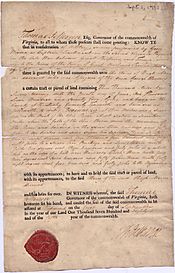
In 1775, Mercer was part of the Fredericksburg Committee of Safety. On April 25, he and others wrote to Colonel Washington. They were worried because the British removed gunpowder from Williamsburg. In August, Mercer was not chosen for leadership in new regiments. This was because he was a "northern Briton." But on September 12, he was chosen as Colonel of the Minute Men. These were from Spotsylvania and nearby counties.
On November 17, 1775, Mercer joined the Committee of Safety for Spotsylvania County. On January 11, 1776, Mercer became a colonel. His group soon became the 3rd Virginia Regiment. The next day, George Weedon became lieutenant colonel. Future president James Monroe and future Chief Justice of the United States John Marshall also served under him. In June 1776, Mercer received a letter. It was from the Continental Congress, signed by John Hancock. It made him a brigadier-general in the American armies. He was asked to go to New York right away. Mercer soon left Fredericksburg to join the Continental Army.
The American Revolution
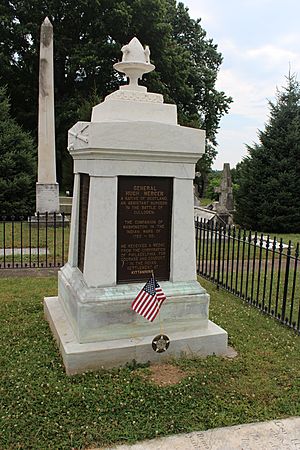
Before the New York City Campaign, Washington ordered two forts built. These forts were to stop the Royal Navy. On the New York side of the Hudson River, Fort Washington was built. Mercer himself watched over the building of Fort Lee on the New Jersey side. The British captured Fort Washington on November 16, 1776. The Americans left Fort Lee four days later. The retreat to New Jersey was called "the Crisis of the Revolution." This was because most of Washington's soldiers' enlistments ended on New Year's Day 1777.
Mercer led a surprise attack on Richmondtown, Staten Island on October 15, 1776. They took control of the town for a short time. They captured people inside a hospital at St. Andrew's Church. But they were pushed back to New Jersey. They released the prisoners. However, they caused many British casualties.
Some stories say Mercer first thought of Washington's plan to cross the Delaware River. This was to surprise the Hessians at the Battle of Trenton on December 26, 1776. Mercer certainly helped a lot with the plan. The victory at Trenton made Washington's men agree to fight for ten more days. When Washington decided to face Cornwallis again, Mercer had a big role. This was during the Second Battle of Trenton on January 2, 1777.
The Battle of Princeton
The next day, January 3, 1777, Washington's army was going to Princeton, New Jersey. Mercer was leading 350 soldiers ahead of the main army. His group met two British regiments and a mounted unit. A fight started in an orchard. Mercer's horse was shot from under him. He got up and was quickly surrounded by British troops. They thought he was George Washington. They told him to give up. He was outnumbered, but he pulled out his sword. He fought bravely. He was beaten to the ground and stabbed many times (seven times) with bayonets. He was left for dead.
When Washington heard about the attack, he joined the fight. Washington gathered Mercer's men and pushed back the British. But Mercer was left on the field. He had many bayonet wounds and blows to his head. A story says that Mercer, still wounded, did not want to leave his men. He was given a place to rest on a white oak tree. Those with him held their ground. This tree became known as "the Mercer Oak." It is now a key part of the seal of Mercer County, New Jersey.
When he was found, Mercer was taken to a field hospital. This was in the Thomas Clarke House (now a museum). Benjamin Rush cared for Mercer and other wounded soldiers. Quakers helped Rush care for the wounded. Local Quakers continued to care for wounded soldiers from both sides. This was after the American army moved North. The Quaker meeting house is next to The Princeton Battlefield State Park. Mercer was badly wounded and died nine days later, on January 12, 1777. In 1840, he was reburied at Philadelphia's Laurel Hill Cemetery.
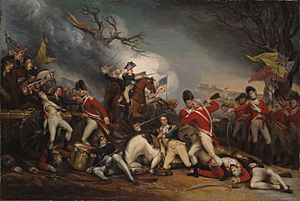
Because of Mercer's courage, Washington went into Princeton. He defeated the British forces there. He then moved his army to Morristown in victory. Because of these wins, most of Washington's army re-enlisted. The French finally agreed to send weapons and supplies to the Americans. A surprised Cornwallis pulled his forces back to New York. He needed to rethink the American successes. The "crisis" had ended. America now had the means to fight. British public support for the war slowly began to lessen.
John Trumbull used Mercer's son, Hugh Jr., as a model for his painting. It is called The Death of General Mercer at the Battle of Princeton, January 3, 1777. A portrait by Charles Willson Peale shows Washington at the Battle of Princeton, January 3, 1777. It shows Washington in the front. Hugh Mercer is lying wounded in the background. Dr. Benjamin Rush and Major George Lewis are supporting him. This portrait is very important to Princeton University. James Peale painted a version of "Battle of Princeton." It shows a blurry picture of Mercer being helped from the ground.
Hugh Mercer's Family and Legacy
Hugh Mercer's family members have achieved great things. His grandson, John Mercer Patton, became a governor in Virginia. His great-great-great grandson was General George S. Patton. Other direct descendants include another grandson, Confederate General Hugh Weedon Mercer. The famous songwriter Johnny Mercer is also a direct descendant.
Hugh Mercer in Film
In the 2000 TV movie The Crossing, Hugh Mercer is played by Roger Rees. This movie shows Washington crossing the Delaware River and the Battle of Trenton.
Places Named After Hugh Mercer
Many places are named in honor of Hugh Mercer:
- Fort Mercer, in National Park, New Jersey.
- Mercer County, New Jersey, where Trenton and Princeton are located.
- Mercer County, Pennsylvania
- Mercer County, Ohio
- Mercer County, Kentucky
- Mercer County, Illinois
- Mercer County, West Virginia
- Mercers Bottom in Mason County, West Virginia.
- Mercer County, Missouri
- The town of Mercer, Maine.
- The town of Mercerville, New Jersey.
- Mercer, Pennsylvania.
- Mercersburg, Pennsylvania.
- Mercer Street in Fredericksburg, Virginia.
- Mercer Street in New York, New York.
- Mercer Street Residence at New York University School of Law.
- Hugh Mercer Elementary School in Fredericksburg, Virginia.
- Mercer Hall at the University of Mary Washington.
Images for kids


